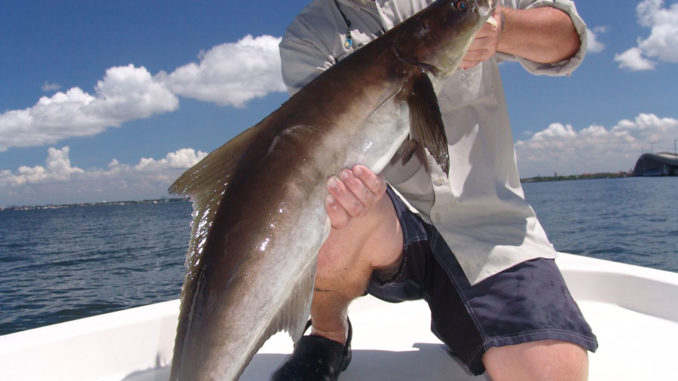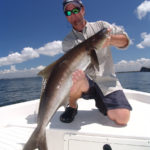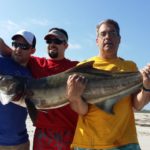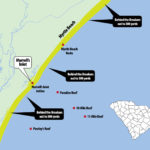
Keep a handful of rods ready whenever you find a big school of baitfish; hungry cobia will be nearby.
As the spring peaks in the Palmetto State, fishermen looking for an opponent built for pure power and brute force won’t have to venture far past the jetties at Murrells Inlet. Early this month, cobia will arrive just off the sandy shores, and they won’t be little ones looking for a safe haven.
Those 50-pound cobia are there because huge schools of menhaden show up as the waters warm. A few sharks and big bluefish will take out a few stragglers on their trip up from Florida, but it’s the schools of cobia that bring out anglers in droves.
Typically, cobia are solitary fish that forage in structure-laden places, such as artificial reefs and natural, high-relief livebottom. They will hover under channel markers, buoys and anything breaking the ocean’s surface will attracts bait. But in May, they congregate in decent-sized schools as the spawn approaches, and they can’t resist the menhaden balled up along the beach. To raise the bar another notch, cobia don’t necessary play nice together when it’s feeding time.
For Capt. J Baisch of Fishfull Thinking Guide Service, it is his favorite time to catch a trophy-sized fish.
“Singles are tough to get to bite at times, but when there are as many as 20 fish, they become extremely aggressive,” said Baisch. “If they have competition for food, they will nail just about anything you throw out there.”
When cobia are around menhaden, they can often be seen cruising the surface. And when 20- to 60-pound brown fish are cruising in a group, sight-fishing takes on a whole, new meaning, especially when they are anxious to eat.
“When they are in a group, they will eat the heck out of everything,” said Baisch, who will use everything from free-lined live menhaden to a very wide assortment of artificial lures. “Big rubber worms in purple or black are extremely deadly.”
Getting them to bite might not be difficult, but finding them is the deal. With the menhaden moving northward ever day, the cobia will stay on the move. Baisch will pull through Murrells Inlets jetties and head down the beach looking for menhaden and cobia suspended just under the surface in the same areas. And just about every stretch of beach from Pawley’s Island to Cherry Grove will feature menhaden.
“The menhaden are everywhere, and we have to go from school to school until we find a pod holding cobia. On some days, we will drive 10 to 15 miles looking and not see a fish, and other times, we’ll finish up with four fish between 30 and 65 pounds without losing sight of the jetties,” said Baisch, who will look for diving pelicans — a dead giveaway that menhaden are in an area.
Capt. Jason Burton of Fly Girl Charters is another Murrells Inlet captain who keeps a tight leash on cobia this month.
“We look for birds hovering over bait, and then we investigate the schools,” said Burton. “When you see explosions in the water or the cobia wallowing in the bait, you know you are in the right place.”
Time of day can have an impact on where the fish will be on any particular day. Burton feels like the bait and cobia tend to be closer to the breakers early and out and deeper later in the day on a sunny day.
“The bait runs the beach early for one reason or another and move out deeper, but it doesn’t mean they will not stay shallow all day, either. Cobia are very unpredictable this time of year,” Burton said.
Often, cobia will shadow a baitfish school, suspended under the surface and out of sight, so Burton will try out a spot that is holding a large pod of bait for a while before going to another spot.
“I will fish a pod for 20 minutes or so and then go to the next one if I don’t see or catch anything,” he said.
Catching multiple fish in a day or from the same school is not out of the question, either, in part because cobia are less spooky than most marine gamefish; Baisch said about a third of his hookups are within a rod’s length of the boat.
“They aren’t scared of the boat much at all. We will pitch a bait right to a cobia, and a hungry cobia will pounce right on it. Last year we had a fish soak us after the fish took the bait right at the boat,” said Baisch, who still doesn’t take anything for granted, analyzing the wind, current and direction the bait is travelling to get in place where things come to him.
A school of cobia may bust up when an angler latches onto a fish and causes the water to froth up, but Baisch will stick around and wait for his turn.
“They don’t want to leave a ready source of food unless forced out. After 20 to 30 minutes, the other fish in the school will re-group and come back to the same school of bait,” he said.
Cobia are around spring and fall, with the biggest concentrations around the nearshore reefs and wrecks. But it’s the action that’s just beyond the breakers that offers fishermen a chance at the best sight-fishing action anywhere you can get to in a small boat on a calm day.
DESTINATION INFORMATION
HOW TO GET THERE — On the southern end of the Grand Strand, Murrells Inlet is easily accessible from US 17 Business, with a public boat ramp just south of Crazy Sister Marina. The first 300 yards off the beach will hold schools of menhaden in May, with cobia shadowing their movements. Cobia will also hold on wrecks and reefs out to 60 feet, including the Pawley’s Reef, 3-Mile Reef, North Inlet Reef, Myrtle Beach Rocks, 10-Mile Reef, 11-Mile Reef, Belky Bear, and Georgetown Reef.
WHEN TO GO — Cobia will show up along the beachfront in late April when the water temperature breaks the 70-degree mark; they’ll stay until early June, then move off to reefs and deep structure for the summer and fall.
BEST TECHNIQUES — Always have several rods rigged when approaching a school of bait, a reef or a single fish sunning at the surface. Pitch live menhaden on a 3/0 to 5/0 hook tied to an 80-pound fluorocarbon leader or slow-troll or freeline a live bait on a king mackerel rig with 80-pound fluorocarbon/monofilament with two No. 4 snelled treble hooks. Artificial lures are an option: 6-inch Gulp shrimp, Yo-Zuri Crystal Minnow, topwater poppers, stick baits, plastic worms, bucktails and jumbo-sized swim baits can all draw strikes. Make sure to use strong and sharp hooks and tackle strong enough to drive home the point into a cobia’s tough mouth.
FISHING INFO/GUIDES — Capt. Jason Burton, Fly Girl Charters, 843-798-9100, www.flygirlfishingcharters.com; Capt. J Baisch, Fishfull Thinking Guide Service, 843-902-0356, www.fishthinkguidesc.com; Pawley’s Island Outdoors, 843-979-4666; Perry’s Bait and Tackle, 843-651-2895. See also Guides and Charters in Classifieds.
ACCOMMODATIONS — Hampton Inn, Murrells Inlet, 843-651-6687; Myrtle Beach Area Convention and Visitors Bureau (www.visitmyrtlebeach.com); South Carolina Association of Visitors Bureaus, www.discoversouthcarolina.com.
MAPS — Navionics, 800-848-5896, www.navionics.com; Waterproof Charts, Nearshore No. 98, 800-423-9026, www.waterproofcharts.com; SeaLake Fishing Guides, 800-411-0185, www.sealakeusa.com.







Be the first to comment